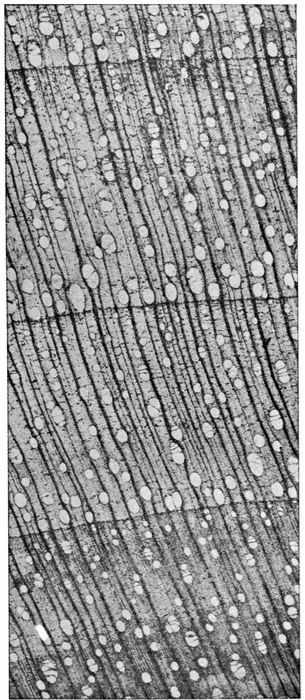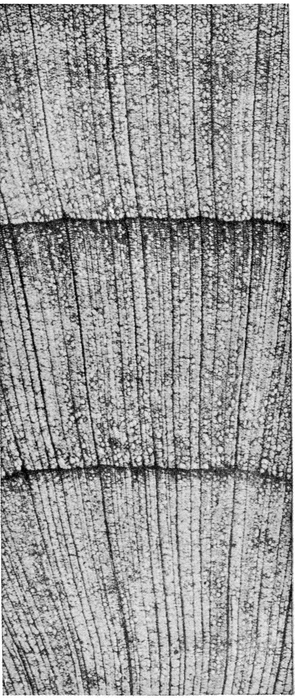ALTHOUGH obviously there are scores of varieties of wood that can be, and have been, carved, it will be found that ordinary wood carving does not employ more than about twenty different kinds. These twenty are favourites because their structure is such that the carvers tools leave a clean, sharp cut, or because their grain is so straight as to enable the wood to be worked with the least amount of trouble and risk of splitting. Of the greatest importance in all woods used for carving is thorough seasoning; where time and convenience allow, it is desirable for the carver himself to stock the wood for a year or two, so that when using it he can be sure that it is thoroughly dry. This chapter gives a few notes on the woods which are in common use by the carver. The woods in most general use are oak, Italian and American walnut, lime, holly, pearwood, chestnut, and mahogany, and these are described in this order below, after which notes on a few of the less-used woods are given.
Oak
Oak, the oldest of woods known to be used for wood carving, is Quercus robur L. (natural order Cupulifer), and is the chief hardwood of Europe. Many varieties of oak are grown in North America, India, Japan, and Australia. It grows to a height of 60 ft. to 100 ft. and has a diameter of 1 ft. to 22 ft. ; a straight oak stem often measures from 30 ft. to 40 ft. high and from 2 ft. to 4 ft. in diameter. When seasoned, the specific gravity of oak is -780 or 597, and when freshly cut 1280. Its weight per cub. ft. is 6243 lb. is a micro-photograph (multiplied 30 diameters) showing the formation of oak wood. Oak is hard, firm and compact, glossy and smooth, with a variable surface. It is a good wood for the use of experienced carvers, but on account of its hardness is not so suitable for the beginner. As already mentioned, oak has great lasting qualities. Most of the carvings of the Middle Ages in the churches and abbeys were wrought from the true British oak. In colour, oak is a light fawn when freshly cut, but on exposure it turns to a handsome brown. The sapwood is very liable to insect attack, but the heartwood under any conditions is very durable. Oak can be obtained in logs from 25 ft. to 50 ft. long by 12 in. to 24 in. square.
Bog-oak
Bog-oak is often used for carving, and in Ireland the carving of this wood is one of the peasant industries, the work produced being small but of good quality. Bog-oak is so called from the fact that it is found embedded in the decaying vegetable matter of the bogs, and the oak itself has often entered on the first stage of putrefaction The wood is hard, close-grained, and brittle, but it is also capable of a very high polish. When ready for sale, it closely resembles ebony. It is a very dark-coloured wood, being almost black. Bog-oak is liable to violent splitting and checking after being excavated, and therefore should the carver himself dig it, he should remember not to remove it from the peat water until a store place is ready for its reception. Chip off the sapwood all round down to the heartwood, following the course of the bends. Saw off all broken ends, and cut away all rotten places ; then stand it for a few days under cover, and allow it to drain. If the design of the proposed furniture is partly curved, take advantage of the natural bends of the wood, and so economise material. Mark off the lengths of straight material in the same way. Then cut up the logs into the shortest lengths possible, allowing for waste, of course. Plank the stuff at the sawyers, and rack it, preferably in an upright bar rack which is tight enough to prevent much warping. Cut the panels, seating, etc., out of the large logs, and use those of smaller dimensions for the square stuff. As bog-oak generally takes three or four years to season, and becomes much harder (and more brittle) as it dries, it is desirable to work it out before it gets thoroughly seasoned. In conversion little attention is paid to the silver grain of the wood. Being black, it does not show much. When, however, the medullary rays are rather pronounced, pairs should be matched as far as possible.
.Micro-photograph of Oak Wocd (Multiplication, 30 diameters).
Walnut
Walnut comes from Juglans regia L. (natural order Juglandace ), now growing in Europe, but originally a native of Northern China and Persia. It grows to a height of 30 ft. to 50 ft., with a diameter of 2 ft. to 3 ft. When green, walnut weighs 585 lb. per cub. ft., and when dry 465 lb. A micro-photograph (multiplied 30 diameters) is presented by . It is a moderately heavy, hard, close-grained wood, and very durable if kept dry. It is dark brown in colour, and is beautifully marked. It is susceptible of a high polish. English-grown walnut is pale, coarse, and perishable, that from the Black Sea being more valuable (logs of this kind as imported measure from 6 ft. to 9 ft. long, and from 10 in. to 18 in. square). Walnut from Italy (Italian walnut) is the best of the walnuts; this is obtainable in planks measuring from 4 in. to 9 in. thick, 10 in. to 16 in. wide, and 5 ft. to 12 ft. long. Italian walnut is a rich and beautifully marked wood, very suitable for carving. Close-grained and hard, it amply repays the extra labour of working it.
American Walnut
American walnut ( Juglans nigra L.), or black walnut, is grown chiefly in Eastern and North America, and grows to a height of 60 ft. to 150 ft., with a diameter of 3 ft. to 8 ft. Its specific gravity is 611 and its weight per cub. ft. is 381 lb. It is hard, tough, and rather coarse-grained. It cleans up to a smooth surface, and takes polish well. It is a capital wood for carving, and it is not liable to split. It is considered less liable to insect attack, more uniform in colour, and darker and more durable than European walnut. In colour American walnut is a violet or chocolate brown, blackening with age. Logs from 10 ft. to 20 ft. long and from 15 in. to 30 in. square are imported. Planks of American walnut can be obtained  in. to 2 in. thick, and boards from
in. to 2 in. thick, and boards from  to 2 in. thick.
to 2 in. thick.
.Micro-photograph of Walnut Wood (Multiplication, 30 diameters).
.Micro-photograph of Lime or Linden Wood (Multiplication, 10 diameters).
Lime or Linden
Lime (corrupted from line) is known also as linden, and appears to be produced by three varieties of trees in the order TiliaceTilia parvifolia Ehrh., T. platyphyllos Scop., and T. argentea Desf., these being spread over Europe, the last-named, however, being found only in the south-east. It grows to a height of from 20 ft. to 90 ft., its diameter being from 1 ft. to 4 ft. Its specific gravity is 794 to 522. shows a micro-photograph (multiplied 10 diameters). It is extensively used by beginners in carving on account of its cheap ness and easy cutting qualities. Soft and pliable to the tool, it splinters less than any other wood. Owing to its colour being white to yellowish-white, it generally requires either staining or gilding. Grinling Gibbons executed much of his beautiful carving in this wood.

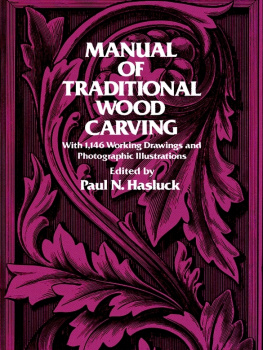

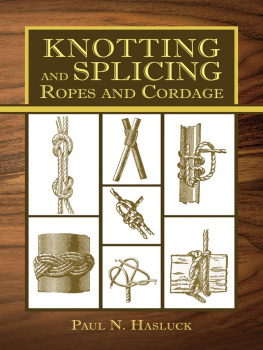
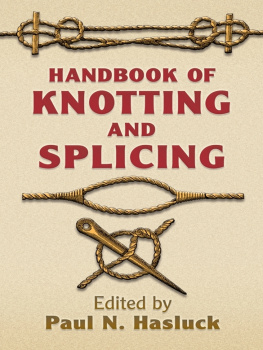





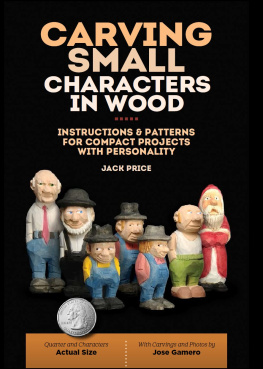
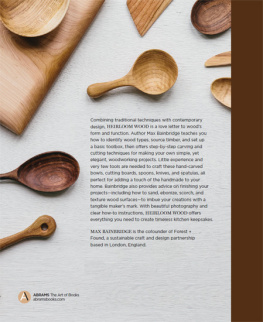

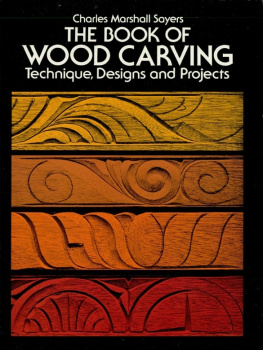

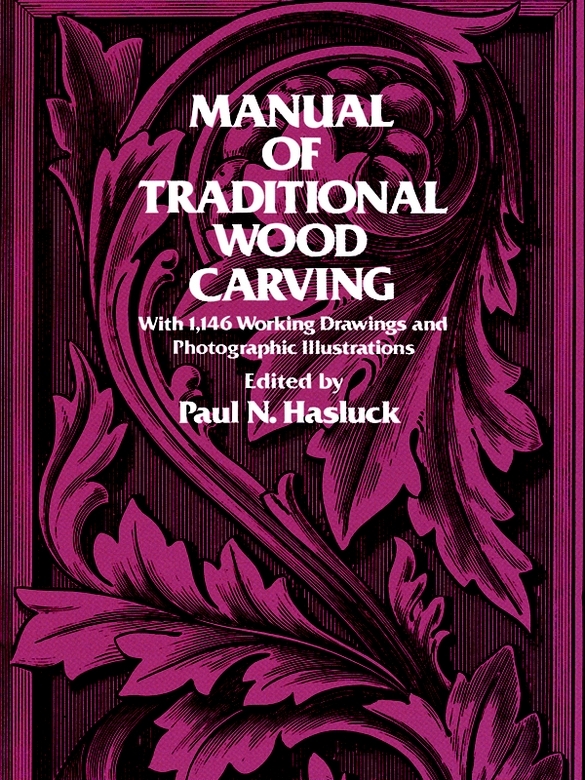

 in. to 2 in. thick, and boards from
in. to 2 in. thick, and boards from  to 2 in. thick.
to 2 in. thick.